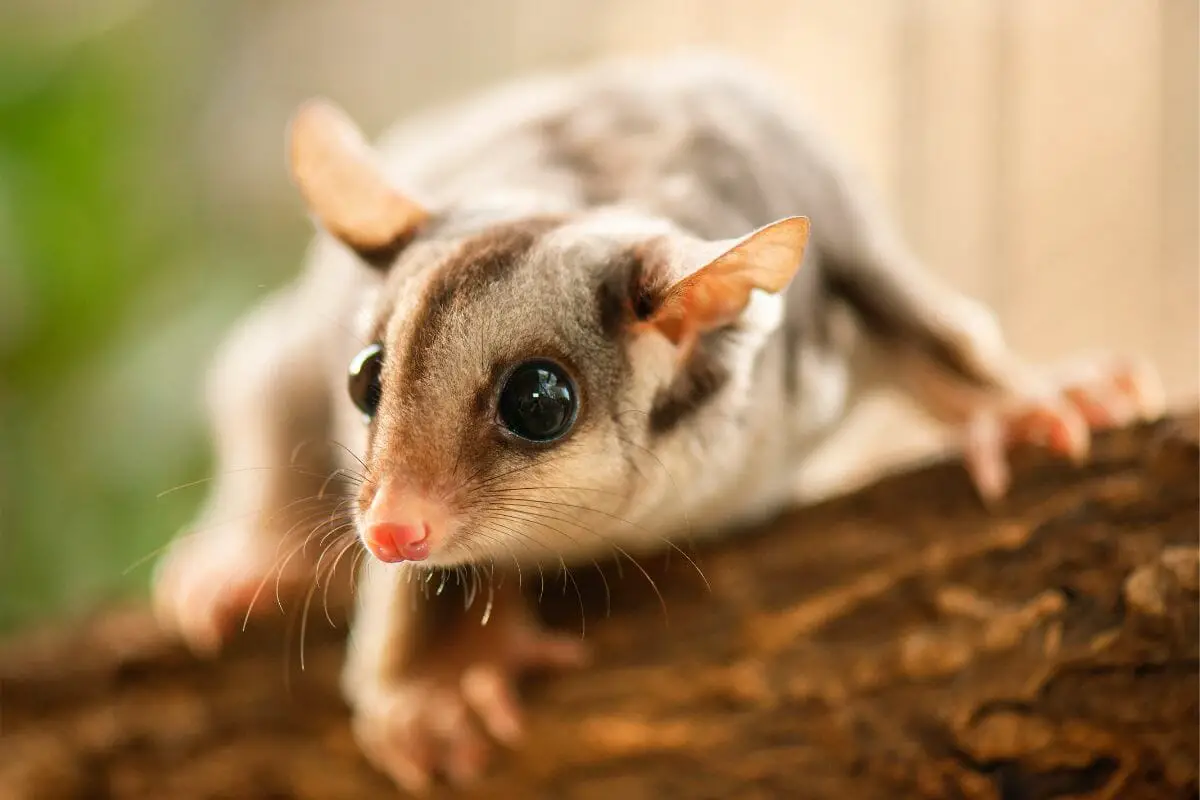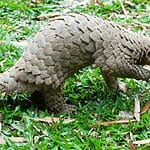The squirrel glider is one of Australia’s iconic animals and is actually part of the possum family.
It does bear a resemblance to these animals, but it also has something that other possums don’t have, the ability to glide.

We take a look at the squirrel glider, its appearance, diet, habitat and behavior among other things.
Appearance
The squirrel glider has a blue-gray fur on its back and a white cream fur on its underside.
There is a dark stripe from the center of its head and down the middle of its back.
Their ears are relatively large, they have a pink nose and a pointed face.
Large eyes give them excellent vision at night which is when they come out to feed.
They are sometimes confused with their relative the sugar glider, but the squirrel glider is larger.
On average, it measures 18-23 centimeters in adulthood and weighs between 190-300 grams. Males are typically larger than females.
A long bushy tail is as wide as the squirrel glider’s body at its base and is the same color as the fur on the rest of its body but with a distinctive black tip.
The ability to glide comes from the delicate, thin membrane that stretches from the squirrel glider’s front to back legs.
These little creatures are very appealing in appearance with their big eyes, pink nose and bushy tail.
Diet
Squirrel gliders are nocturnal creatures and come out at night to feed.
They are omnivores which means they have a mixed diet of insects and plant based food such as leaves and sap.
In particular the squirrel glider will feed on the eucalyptus tree’s pollen, nectar and flowers.
But they also eat the resin or sap from Acacia gum trees and the green seeds of the Golden Wattle trees.
The insects that the squirrel glider eats vary from caterpillars to beetles but their diet varies with the seasons, and they will eat what is readily available.
They have been known to eat bird eggs and even small birds.
At night the squirrel glider forages in the trees and shrubbery to find food. It is a light and agile climber and can glide up to 50 meters between trees looking for food.
Habitat

Unsurprisingly the squirrel glider lives in areas that are abundant in eucalyptus and acacia trees as these are its main source of food.
They also use the leaves to line their nests where they huddle together to keep warm.
The nests are usually close to where the squirrel gliders will spend their time foraging for food at night.
However, each individual may have 2 or 3 different nests.
Other tree species that squirrel gliders rely on for food and habitat are Yellow Gum, Long-leaved Box, White Box and Red or Mugga Ironbark.
At least one of these needs to flower in the winter to provide the squirrel glider with a larger variety of insects to feed from.
They prefer to live among smooth bark eucalyptus trees as these are more likely to have hollows which the squirrel gliders turn into nests.
As the larger of the two, the squirrel glider tends to dominate any suitable habitat leaving the smaller sugar glider to seek food and nests elsewhere.
The fact that numbers of squirrel gliders is declining demonstrates that the abundance of suitable habitats are shrinking.
Behavior
As an arboreal creature the squirrel glider is a nimble and agile climber.
Not only is it light but its ability to glide gives it the advantage of being able to stay in the treetops away from potential threats and predators.
On flat terrain they can glide up to 50 meters but on a downward slope they have the ability to glide for more than double that distance.
In order to steer the squirrel glider alters the curvature of either the right or left membrane.
In order to land, they bring their rear legs closer to their body and make an upward swoop to slow their descent.
They will then land on all four legs gripping the bark of the tree.
During the day squirrel gliders remain hidden in their nests only coming out at night.
Their eyes are perfectly adapted to night activity, and they move along tree branches in small bounding movements.
If they are caught in a beam of light the squirrel glider will freeze or hide behind branches or leaves to avoid detection.
Breeding
Breeding age is reached when the squirrel glider is around 12 months old.
Mating can take place at any time of the year, but availability of food often dictates when breeding occurs.
Males have a scent gland on the dark stripe of their head which they use to attract females.
The squirrel glider is polygynous which means the male will mate with several females during the breeding season which usually begins in August.
Female squirrel gliders will typically have one litter of young per season but if conditions are good they may have two.
Being a marsupial the female gives birth to underdeveloped young who then make their way through her fur to the pouch where they attach to one of her teats.
They remain in the pouch for up to 70 days and continue to grow and develop.
The mother squirrel glider will then place the young in the nest while she forages for food.
The young will leave the nest at around four months of age.
A family group will usually consist of a mature male over the age of two and a couple of mature females with their offspring.
Distribution
Although the squirrel glider is native only to eastern mainland Australia its distribution is quite wide in this region.
They can be found from Cape York peninsula in Queensland to central Victoria.
The squirrel glider is widely distributed along the Great Dividing Range between southern Queensland and central New South Wales favoring the coastal side of the range.
In the far northeastern reach of the squirrel glider they tend to inhabit dry and open sclerophyll forests, Banksia woodland, and coastal forests.
In northern Queensland they live in lemon-scented and forest red gum trees as well as ironbark.
In other parts of Queensland these animals live in wet eucalyptus forests but are rarely found in rainforests.
They are also known to inhabit urban areas such as the suburbs of Brisbane.
Communication

The sounds that the squirrel glider makes vary from a soft guttural call with a slight nasal sound to a gurgling chatter.
When a predator is detected they will communicate this to each other with a yipping sound.
Threats
There are unfortunately many threats to the squirrel glider.
Predators such as feral cats and foxes are a problem as they are an introduced threat and not something squirrel gliders would face in their natural habitat.
The loss of trees that readily bear hollows contributes to the lack of nesting sites for these animals which will of course have a negative effect on their numbers.
Deforestation is a huge blow to them too as not only do they rely on trees for food and shelter but also as a means of safely traveling through their habitat.
By staying high in the treetops they avoid predators and can move around an area to feed and mate.
But when the trees are cut to make way for roads, railways or other construction this lifeline for the squirrel glider is eliminated.
Fire is another threat and reduces the number of trees that the squirrel gliders rely on for food and nesting.
Sadly the use of barbed wire also contributes to the loss of numbers of these creatures.
By replacing the top strand of these fences with plain wire the number of injuries and deaths could be reduced.
Conservation Status
The conservation status of squirrel gliders varies according to the region that they live in.
New South Wales lists them as vulnerable, in Victoria they are classified as threatened, and in South Australia they are endangered.
However, in Queensland the squirrel glider is considered common.
The fragmentation of their habitat is the main reason for the decline of squirrel gliders in the areas where they are vulnerable, endangered or threatened.
Deforestation removes their food source, nesting sites and ability to move around their habitat.
The introduction of barbed wire fences has compounded the problem as well as the introduction of feral cats and foxes.
There are things that we can do to mitigate the losses of squirrel gliders. Replacing some barbed wire fencing with plain wire can help reduce injuries and potential deaths.
Keeping domestic cats in at night or fitting them with bells can give the squirrel gliders a chance to feed in safety at night and protect young.
Final Thoughts
Squirrel gliders are an important and endearing part of Australia’s fauna.
We hope you have enjoyed this guide to the squirrel glider and that it has given you some insight into their behavior, appearance, diet and habitat.









